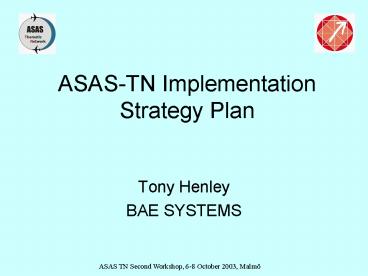ASASTN Implementation Strategy Plan - PowerPoint PPT Presentation
1 / 12
Title:
ASASTN Implementation Strategy Plan
Description:
Operational definition. Technology. ACAS/ASAS Integration. Equipage Rates. Certification ... high density of equipped aircraft per selected sector or TMA ... – PowerPoint PPT presentation
Number of Views:72
Avg rating:3.0/5.0
Title: ASASTN Implementation Strategy Plan
1
ASAS-TN Implementation Strategy Plan
- Tony Henley
- BAE SYSTEMS
2
Overview
- Implementation Challenges
- Work In Progress
- The Way Forward
3
Implementation Challenges
- Operational definition
- Technology
- ACAS/ASAS Integration
- Equipage Rates
- Certification
- Large scale Validation
- Investment costs vs benefits
4
Work In Progress
- Research Programmes
- MA-AFAS, AFAS, NUP III, MFF
- Requirements Focus Group
- Coordinates European and US Activity
- OSED Harmonisation Group
- Standardising applications
- feeds SPR/INTEROP activities
- Integration with other tools/capabilities
- (C-ATM, SEAP, LAVA/NUP III)
5
Base Line StrategyConsiderations
- Retrofit vs Forward fit
- ATSAW vs new operations
- Core Europe vs city pairs
- Many small steps vs few big leaps
6
Retrofit vs Forward fit
- ASAS requires a fleet of interacting aircraft
- 1 A/c per hour per airport will not give benefits
- Estimate 40-50 equipage in sector/TMA required
to evaluate benefits - 5000 large commercial aircraft in Europe
- most with another 10 years of life
- Forward fit will give 50 equipage by 2018?
earliest
7
ATSAW vs New operations in European Radar
airspace
- ADS-B Out - (without intent )
- no additional information
- no cost justification
- ATSAW -(ADS-B In)
- new information to pilots
- under ATC radar control, cannot be used
- (except on airport surface)
- no operational benefit
- ASAS Manoeuvres SVA, SM, CP
- Measurable operational benefits
- potential cost justification
8
Initial Deployment
- large scale validation
- high density of equipped aircraft per selected
sector or TMA - city pair-e.g Madrid Barcelona -or hub
- one or two airlines
- small number of aircraft types
- problem in core Europe -
- many airlines and aircraft types
- difficult to achieve the density quickly
- higher costs
9
The Way Forward
- Two phases of equipage
- Phase 1 at Local/Regional Level -
- ADS-B in and Out with Maneuver Guidance
- Near term
- Demonstrate benefits to airlines
- Minimise impact on ground infrastructure
- Phase 2
- Fully integrated avionic solution (new FMS)
- Integration of ASAS with 4 D trajectories and new
ATC tools
10
Phase 1 (2007)
- Package 1 validation
- Focus on functions giving operational benefits
- Start with high density sector with few airline
- No change in separation responsibility
- On ground
- Minimal change to ground infrastructure
- Necessary enhancements to CWP MMI
- In Air
- Single avionic unit incorporating surveillance
database and manoeuvre generator - Manual control of manoeuvres via autopilot
11
ASAS Prerequisites
- Pilot Support
- Controller support
- Accountant support ( Airlines ANSPs)
- Therefore
- Responsibilities must be clear
- Safety must be maintained
- Benefits must justify investment
12
End

